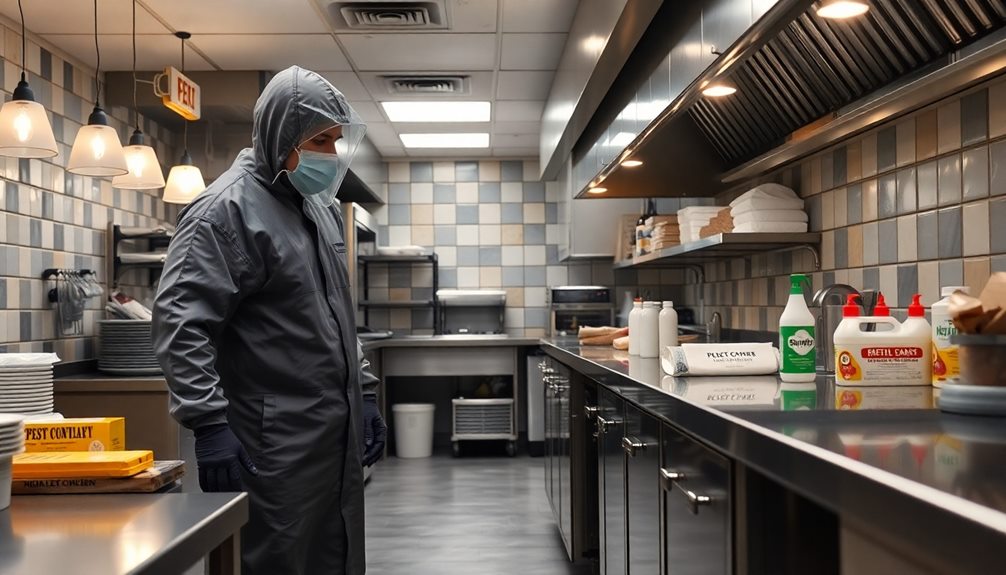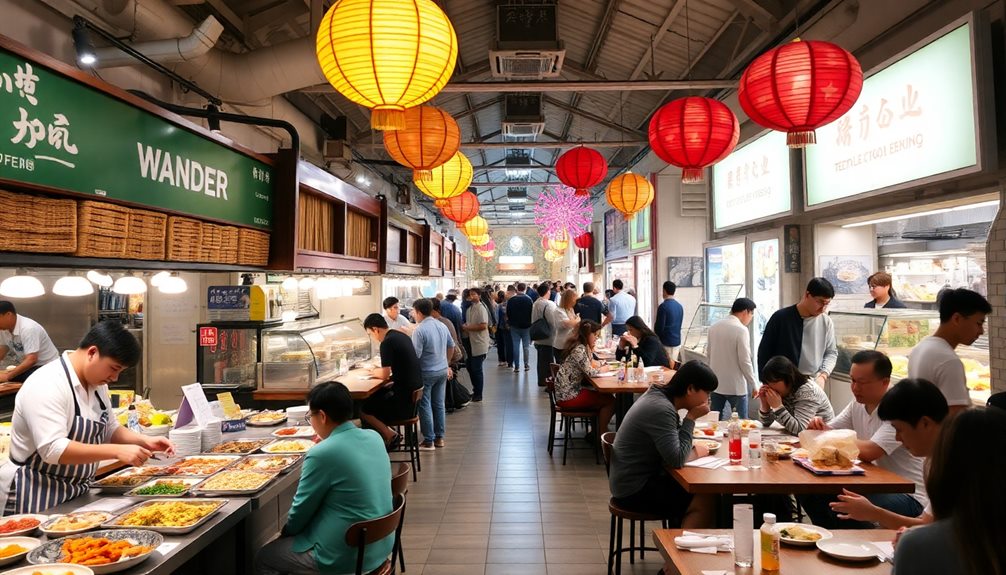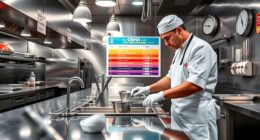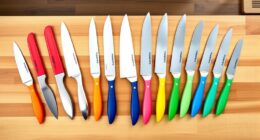To design an efficient restaurant kitchen, start by choosing a layout that promotes logical workflow, like the island or assembly line design. Utilize space effectively with wall-mounted shelving and pegboards to keep tools organized. Invest in user-friendly, energy-efficient equipment that aligns with your menu, while incorporating automation tools to reduce errors and enhance productivity. Introduce color coding to improve safety and organization. Guarantee proper lighting for a comfortable working atmosphere. By focusing on these elements, you can create a space that maximizes efficiency and meets your operational goals. Discover more strategies to elevate your kitchen's design.
Key Takeaways
- Choose an optimal kitchen layout that promotes logical flow between delivery, storage, preparation, cooking, and dish return areas.
- Utilize vertical storage solutions and pegboards to organize tools, maximizing space and reducing kitchen clutter.
- Invest in energy-efficient equipment and user-friendly technology that aligns with your menu to streamline operations and lower costs.
- Implement real-time data management and kitchen display systems to enhance communication, reduce errors, and improve inventory control.
- Prioritize safety through organization, color coding, and proper sanitation protocols to increase productivity and minimize cross-contamination risks.
Choose the Right Layout

When designing a restaurant kitchen, choosing the right layout is essential for ensuring smooth operations. Selecting a kitchen layout design—like island, zone, or assembly line—maximizes efficiency and meets your restaurant's specific needs.
A well-planned design includes designated areas for delivery, storage areas, food preparation area, cooking stations, and dish return, promoting a logical flow of ingredients and minimizing delays.
Remember, accessibility to equipment and supplies is important; your layout must facilitate quick movement between key areas. This not only enhances staff productivity but also speeds up service.
The standard space allocation for restaurants emphasizes that approximately 40% of your total area should be dedicated to the kitchen, so measure your space carefully to optimize functionality.
Consider implementing modular designs, which offer flexibility for future menu changes and adaptations. This way, your kitchen can evolve alongside the restaurant's needs.
Effective communication and supervision in a well-structured kitchen layout can further enhance productivity, ensuring that your team works seamlessly together.
In short, a thoughtful kitchen layout is a significant investment in your restaurant's success.
Utilize Space Wisely

Maximizing your kitchen space is vital for running an efficient restaurant. Start by implementing wall-mounted shelving units to enhance vertical storage. This not only keeps essential tools accessible but also makes the most of your limited kitchen space.
Pegboard systems can further help organize kitchen tools and equipment, promoting clutter reduction while improving workflow by ensuring quick identification and access. Additionally, consider incorporating farmhouse kitchen textiles that can add both charm and functionality to your kitchen environment.
Consider modular designs that adapt to your kitchen's specific needs. This approach allows you to optimize space in compact areas and provides the flexibility for future reconfigurations without major renovations.
Analyze storage solutions by categorizing items into essential versus non-essential. This helps maintain an organized environment and maximizes available kitchen space.
For smaller kitchens, like a 160 sqft pizza kitchen, leveraging vertical storage options and multi-functional equipment is imperative. This strategy reduces clutter while ensuring all necessary tools and ingredients remain within easy reach, enhancing both accessibility and efficiency.
Use the Right Equipment
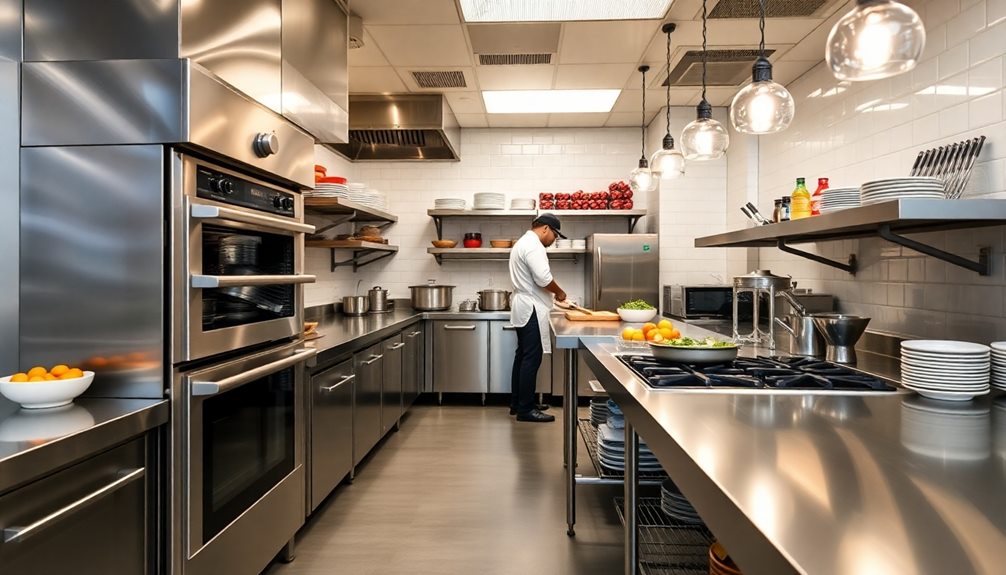
Choosing the right kitchen equipment is essential for your restaurant's efficiency and success. When designing your commercial kitchen, you need to select user-friendly kitchen equipment that reduces training time for your staff. This allows quicker adaptation to daily operations and enhances overall efficiency.
Essential tools like gas range-oven combos and commercial fryers should align with your menu items to meet culinary needs effectively without unnecessary complexity. Additionally, incorporating a preventive maintenance strategy helps guarantee your appliances remain in peak working condition, further supporting your kitchen's efficiency.
Consider the daily workload capability of your kitchen. High-volume operations may need multiple cooking stations or larger appliances to handle peak service times efficiently. Additionally, confirm your kitchen equipment promotes food safety and integrates well with your storage spaces to keep everything organized.
Investing in energy-efficient equipment not only lowers your operational costs but also supports sustainability goals, maximizing efficiency in your kitchen operations. By choosing the appropriate equipment and supplies, you'll streamline your cooking area and improve workflow, guaranteeing your restaurant runs smoothly.
Prioritize these elements, and you'll create a kitchen that's both functional and aligned with your restaurant's vision for success.
Incorporate Automation

Incorporating automation in your restaurant kitchen can transform how you operate.
Streamlined ordering systems reduce errors and improve communication, while robotics in food prep can boost efficiency during busy hours.
Plus, real-time data management helps you optimize workflows and inventory, ensuring you stay ahead of the game.
Streamlined Ordering Systems
To streamline your restaurant's ordering system, look into implementing automation that can transform your kitchen operations. By integrating automated ordering systems, you can reduce human errors by up to 30%, enhancing accuracy in order fulfillment and boosting customer satisfaction. This not only improves the overall efficiency of your food production but also allows your kitchen staff to focus on higher-value tasks.
Additionally, staying informed about personal debt forgiveness bills can help you manage your restaurant's financial responsibilities more effectively.
Real-time data tracking from these systems aids in better inventory management, minimizing food waste and ensuring that ingredients are always available. Additionally, incorporating kitchen display systems (KDS) enhances communication between front-of-house and back-of-house, reducing ticket times by as much as 25%. This streamlined order processing plays a vital role in optimizing your commercial kitchen design and kitchen layout.
Automated food preparation tools can handle repetitive tasks, allowing your team to devote their skills to more complex cooking processes. Partnering with technology providers can further lower labor costs, with some businesses reporting savings of up to 20% in staffing expenses.
Robotics in Food Preparation
Harnessing robotics in food preparation can transform your kitchen operations, making them more efficient and consistent. By automating repetitive tasks like chopping, mixing, and assembling dishes, you can greatly reduce labor costs while improving food quality.
Robotic arms, for instance, can work continuously and perform tasks up to 3-4 times faster than humans, especially during peak service times, boosting overall kitchen efficiency.
Moreover, integrating robotics enhances safety by minimizing human contact with raw ingredients, which helps reduce contamination risks and guarantees adherence to health regulations. This focus on safety is essential in a commercial kitchen where food quality and hygiene are paramount.
With real-time data from robotic systems, you can easily monitor inventory levels and operational efficiency. This capability allows you to make informed decisions about resource allocation, reducing waste and optimizing your kitchen's performance.
Successful collaborations with tech companies like ContekPro and Picnic demonstrate the considerable potential of robotics in revolutionizing food preparation processes. By adopting automation in your kitchen, you're not just keeping up with industry trends; you're setting new standards for efficiency, safety, and quality.
Real-Time Data Management
Implementing real-time data management can greatly streamline your restaurant kitchen's operations. By utilizing automated ordering systems, you can considerably reduce human errors, leading to improved accuracy in food preparation and faster service times.
Real-time data management allows you to track inventory levels, enabling timely reordering and minimizing food waste, which not only saves costs but also enhances sustainability efforts.
Using kitchen display systems (KDS) fosters seamless communication between your front-of-house (FOH) and back-of-house (BOH) teams. This can cut ticket times by as much as 25%, boosting operational efficiency.
Additionally, automation in food prep and assembly can decrease labor costs by up to 30%, letting your staff focus on higher-value tasks and improving kitchen workflow.
Integrating real-time data analytics empowers you as a restaurant manager to make informed decisions regarding equipment usage, staffing needs, and menu adjustments based on customer preferences and trends.
Optimize Lighting

Optimizing lighting in your restaurant kitchen is essential for enhancing both safety and efficiency. Proper lighting design not only improves kitchen visibility but also adheres to safety regulations, reducing accidents during busy service hours. Incorporating task lighting at workstations minimizes eye strain, helping your staff focus on food preparation and cooking with precision.
Additionally, consider integrating energy-efficient lighting options, like LED fixtures. These not only lower electricity costs but also create a more comfortable working atmosphere, boosting worker productivity. A well-lit kitchen can transform the pace at which your team operates, making tasks feel manageable and less stressful.
Here's a quick reference table to highlight the benefits of optimized lighting:
| Benefit | Description | Emotional Impact |
|---|---|---|
| Enhanced Safety | Reduces accidents, ensuring a secure workspace | Peace of mind for staff |
| Improved Productivity | Bright, even lighting boosts efficiency | Increased morale |
| Sustainable Environment | Natural light reduces energy consumption | Commitment to sustainability |
| Reduced Eye Strain | Task lighting aids in precision | Less fatigue, more focus |
Implement Color Coding
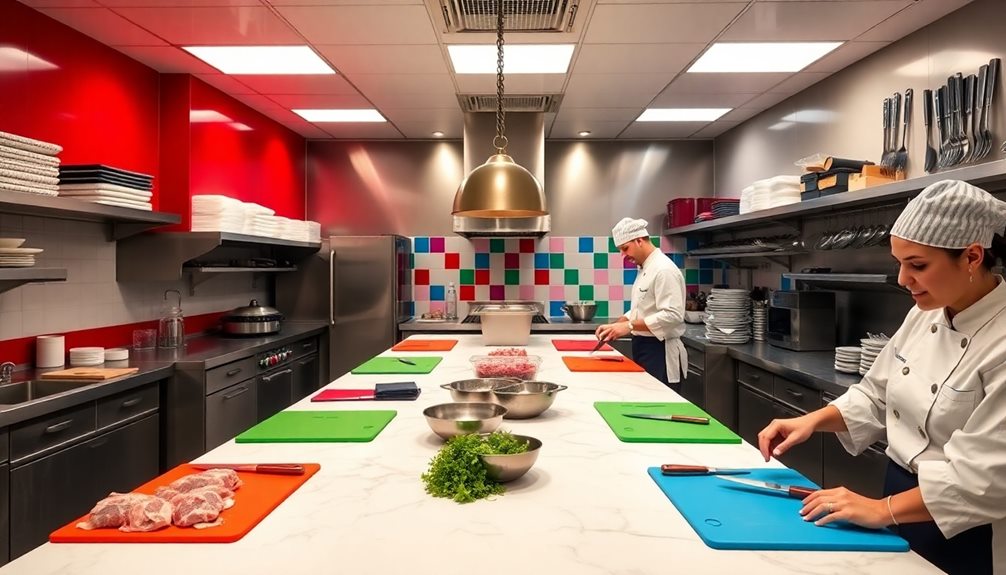
Implementing color coding in your kitchen can dramatically enhance tool organization and improve safety standards.
By using specific colors for different food items and tools, your staff can quickly identify what they need, reducing search time and the risk of cross-contamination.
This simple strategy not only streamlines operations but also helps maintain a clean and efficient workspace.
Enhanced Tool Organization
Color coding your kitchen tools can transform the way your staff navigates their workspace. By implementing a systematic color-coded organization, you'll allow your team to quickly identify tools, greatly reducing search time, especially during peak hours. This method enhances overall efficiency, enabling your staff to focus more on food preparation rather than hunting for supplies.
Incorporating color coding into your kitchen design categorizes items based on their function, which not only promotes cleanliness but also keeps your environment organized. When your tools are visibly sorted by color, it becomes easier for staff to maintain a tidy workspace and adhere to safety practices.
Training your team on this color-coded system fosters a more systematic arrangement, allowing for faster access to essential tools and improving workflow.
Additionally, a color-coded inventory system simplifies stock management; your staff can quickly identify low supplies and reorder as needed.
Improved Safety Standards
A well-organized kitchen is vital for maintaining safety standards, and a color-coded system plays a significant role in achieving this. By implementing color coding for your kitchen supplies—like cutting boards, utensils, and storage containers—you enhance organization and allow for quick identification. This reduces the risk of cross-contamination, a key factor in health and safety for any food service establishment.
Incorporating color coding into your commercial kitchen layout improves efficiency by minimizing the time staff spends searching for tools and ingredients. With a streamlined workflow, you can see an increase in overall kitchen productivity of up to 20%.
Furthermore, a color-coded system supports cleanliness by serving as a visual reminder for staff to adhere to sanitation protocols, especially in prep areas and around handwashing stations.
Additionally, color coding aids in training new employees, helping them quickly grasp kitchen safety and operational procedures. By adhering to these vital design principles, you create a safer, more efficient kitchen that prioritizes both productivity and hygiene.
This not only enhances your kitchen's functionality but also fosters a culture of safety and cleanliness among your team.
Develop an Environmental Plan
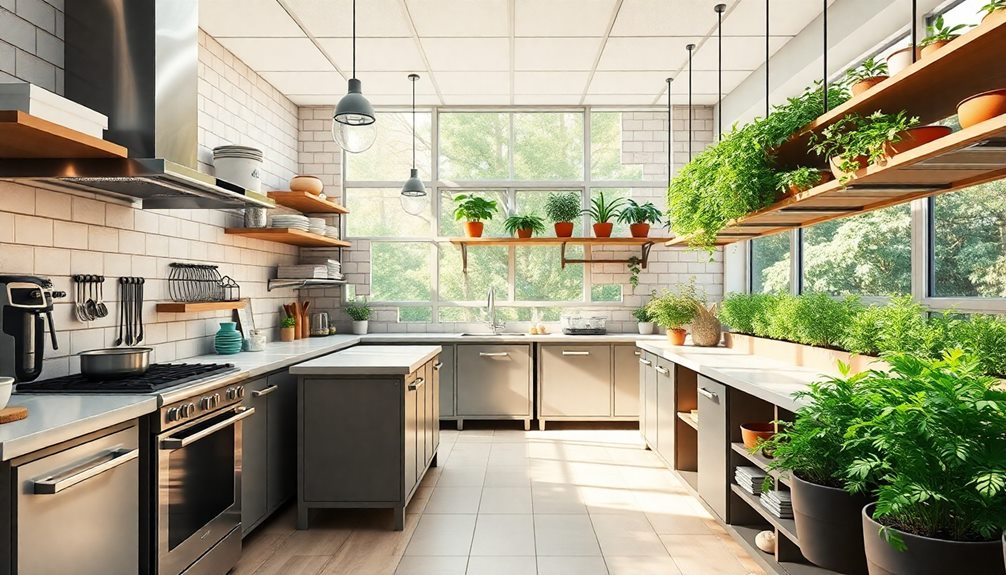
Developing an effective environmental plan for your restaurant kitchen can greatly enhance both sustainability and operational efficiency. By integrating energy-efficient appliances, you can cut operational costs by up to 30%. Incorporating renewable energy sources like solar panels not only reduces energy bills but also minimizes your carbon footprint.
Modular kitchen designs promote eco-friendly practices by cutting construction waste by as much as 70%. Additionally, minimizing single-use plastics supports sustainability efforts and meets the growing consumer demand for environmentally responsible dining options. Finally, well-insulated kitchens help maintain temperature control, resulting in lower heating and cooling costs.
Here's a quick overview of key elements for your environmental plan:
| Element | Benefit |
|---|---|
| Energy-efficient appliances | Reduce operational costs by 30% |
| Renewable energy sources | Lower energy bills, minimal carbon footprint |
| Modular kitchen designs | 70% reduction in construction waste |
| Minimized single-use plastics | Aligns with eco-friendly practices |
Frequently Asked Questions
What Are the 6 Rules for Designing a Restaurant Kitchen?
To design a restaurant kitchen, focus on layout efficiency, comply with safety regulations, use flexible designs, maximize space, implement effective communication systems, and prioritize sanitation. These rules will enhance operations and improve overall service quality. Additionally, consider the importance of the customer experience by incorporating elements that provide comfort and accessibility, such as adequate seating and well-placed equipment for staff. To complement the kitchen’s functionality, the best restaurant bathroom design ideas should also be integrated, ensuring cleanliness and aesthetic appeal that reflect the overall theme of the restaurant. By paying close attention to these details, you can create a harmonious and efficient environment that impresses both staff and diners alike.
How to Make a Restaurant Kitchen More Efficient?
To make your restaurant kitchen more efficient, focus on creating distinct zones for tasks, maximizing vertical storage, investing in user-friendly equipment, incorporating automation, and ensuring proper lighting to enhance workflow and safety.
What Is the Best Kitchen Layout for Efficiency?
When considering the best kitchen layout for efficiency, think about your kitchen's size and workflow. An island or zone layout might enhance communication, while assembly lines boost speed. Choose what fits your needs and staff dynamics best.
How Should a Restaurant Kitchen Be Laid Out?
You'll want to layout your kitchen to enhance workflow. Create distinct zones for each task, minimize distances, and guarantee compliance with health regulations. A well-planned space boosts efficiency and keeps your team moving smoothly during service.
Conclusion
By designing an efficient restaurant kitchen, you're not just creating a workspace; you're building a culinary kingdom! With the right layout, equipment, and a sprinkle of automation, you'll have your staff whipping up dishes faster than a superhero in a rush. Optimize your lighting and color code everything, and watch your kitchen transform into a well-oiled machine. So go on, release your inner kitchen wizard and turn that chaotic cooking space into a masterpiece of efficiency!


